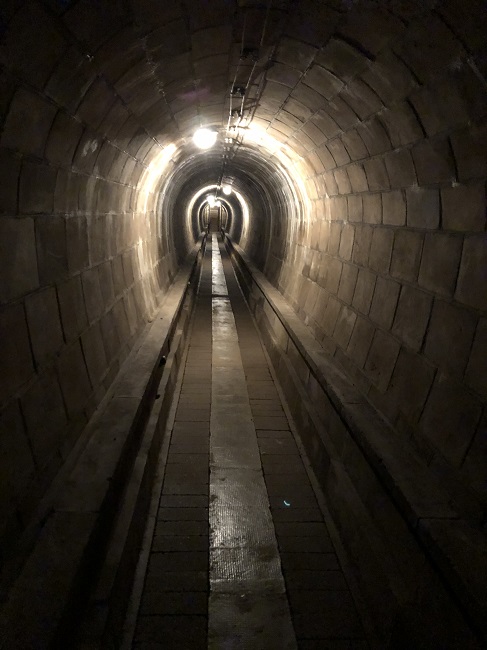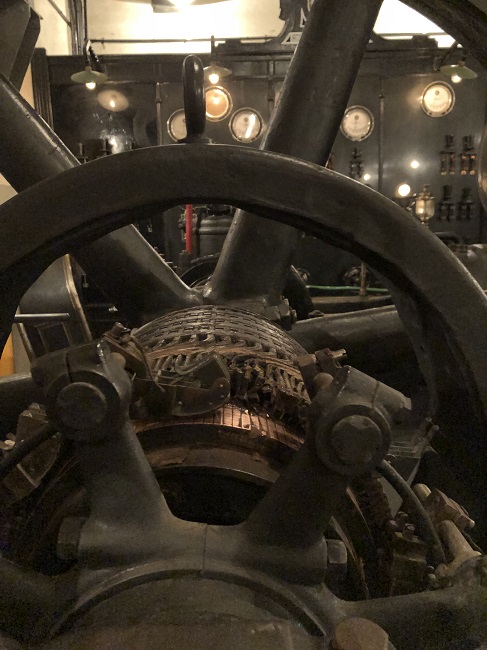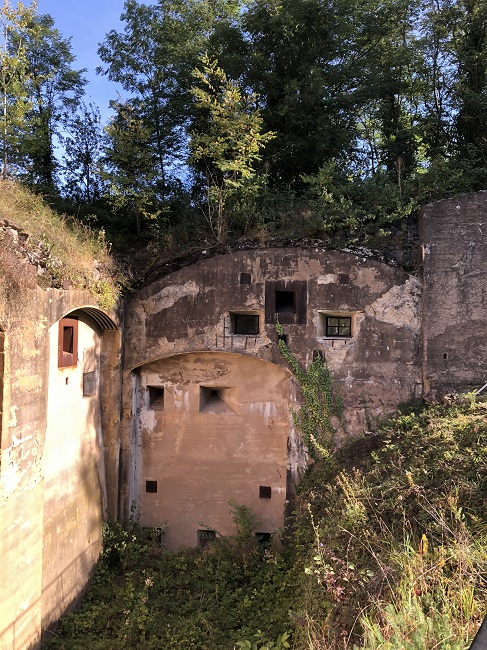HERE AND THERE CANNON AND HOWITZER TURRETS STICK OUT OF A PASTORAL DECOR OF MORE THAN 250 HECTARES. THIS IS THE PART EMERGING FROM A 40,000-M² UNDERGROUND WORLD OF WAR, THE WORLD’S FIRST FORT IN CEMENT WITH ELECTRICITY.
The view is idyllic: the Black Forest can be clearly seen to the East, the Vosges and Kronthal to the west, from the huge flat promontory that has become the levelled off summit of the hill overhanging Mutzig.

And yet a war machine is spread out beneath your feet. You would never know that it was there: Mutzig fort, or Feste Kaiser Wilhelm II, was the first armoured fortification to be built underground in concrete from 1893 to 1916 and connected to electricity.
The fort was nothing like anything that had been built until then, started at a time when fast progress was being made in artillery. Moreover it more than just a simple fort, it is a fortified group of several independent structures, dispersed and integrated into the land, connected by underground galleries. When the First World War started the structure extended to the neighbouring hills to double in size between 1914 and 1916.
AT THE DOORS OF FRANCE
Why build a structure of such a scale at Mutzig? “We are at the end of the road and railway that crossed the Vosges, towards France”, answers Bernard Bour, chairman of the Mutzig Fort association, which opened the doors to the place in 1995, and manages its maintenance and repairs, and tours.
The Vosges had indeed become a border in 1871, following the Franco-Prussian war, when Alsace was integrated into the newly created second German Reich. Its emperor, Wilhelm II, sided with the modernists in his army to use concrete to build turrets here, with armour and electricity”, Bernard Bour continues.
[ALSO READ >> MAMCS, UNE EXPOSITION POUR VALORISER LA RICHESSE ARTISTIQUE DE NOTRE TERRITOIRE]
BLOCK THE ENEMY FOR TWO MONTHS
This military achievement made sense, guardian of one of the borders of the huge German empire established at the heart of Europe, from Colmar to Koenigsberg (Kaliningrad). “It was a real nightmare for the general staff because it took two months to transport reinforcements from one side of the empire to the other. The fortifications were therefore vital for blocking the enemy for at least two months”.
They therefore spared no expense: 22 heavy canons (six batteries) and eight armoured light canons, backed up by mobile batteries, made up the fort’s arsenal. But you only get a fragmented idea of the fort wandering around the site: only 10% of it can be visited. On the other hand when you go inside you get an idea of how huge it is.

DELUSIONS OF GRANDEUR
Getting down to one of the two infantry shelters that can be visited is easy. But moving around is delving into a kind of science fiction from the past, with delusions of grandeur and conquests. The infantry shelter is a giant underground barracks, well sheltered from bombs thanks to its 2.5-metre thick concrete walls.
Around 13,000 m3 of concrete were needed. The cement came from Héming, near Sarrebourg, and Heidelberg, on the other side of the Rhine. It was delivered to Mutzig train station, and transferred on a narrow track at the foot of the hill, then by a funicular railway to the summit. There, 20 kilometres of track had been laid especially for building it.
[ALSO READ >> LE MOIS D'OCTOBRE NOUS MOBILISE, FRAIS COMME L'ILL... ROSE COMME UN RUBAN DE SOLIDARITE]
INTO THE DEPTHS OF THE FORT
Visitors are struck by the almost surgical atmosphere when they enter the first rooms in the shelter. Five undermined galleries plunge from a long corridor, behind the counterscarp wall (one has collapsed) built by Russian war prisoners: their abandoned pneumatic drill shows this forced labour. A level lower you find yourself in a “new” type of gallery: it was built in 1913 and is egg-shaped, much more resistant than the previous ones to soil compression under the expected vibrations shells would create. Here you are 17 metres underground.

This gallery leads to a second shelter that can be visited that makes the daily life of the soldiers stationed there more tangible: “7,000 reserve soldiers when war was declared”, Bernard Bour points out.
ENEMY NO. 1
If the fort is a military achievement, comfort in the rooms was relative: one sink for two rooms (48 men); they were heated, but only at night; there was the permanent noise of the ventilation to ensure air renewal, it was cramped, and damp, the terrible enemy of men and equipment. “One of the fort’s military doctors wrote ‘Half my men are sick’”, says Bernard Bour.
There was also an infirmary, wells to provide 20 litres of water per day and per man, and a bakery. “Here we have the first electric kneading machine the Germans had built. And the oven is a boat oven, because it if was built in brick it would have been subject to vibrations from the firing”.
WILD ORCHIDS
The only one of the fort’s four power stations still working is impressive, there are highly perfected diesel engines; the canons, 14 turrets, telescopes and periscopes are a reminder of what the place was intended for: war.
Suddenly coming back out into nature outside is like experiencing something unreal. A new, more peaceful ecosystem has flourished on this chalky hill in the Vosges: hornbeams, Scots pines, walnut trees, black locusts, wild orchids, butterflies...
This delights Bernard Bour, who has known the place like the back of his hand since he was a teenager and whose association has greatly contributed to saving the structure from slow but sure dereliction. “But all that is just theory! The fort was built to a plan that was never approved...” Pure anticipation...


Cette centrale électrique équipée de quatre moteurs diesel était vitale pour la ventilation, le téléphone, l’électricité, la radio - © Lucie Michel
L’entrée de la partie visitable est bien ici - © Lucie Michel
Auteure : Lucie Michel
Mutzig Fort, open every day from 1pm to 3pm during the week and from 10am to 12pm and from 1pm to 3pm on weekends and public holidays, as self-guided visits with a written guide. Guided tours can be booked on 00 33 (0)6 71 94 12 67 (during opening times).
Mutzig fort is part of the Touristic Sites of Alsace (STA)